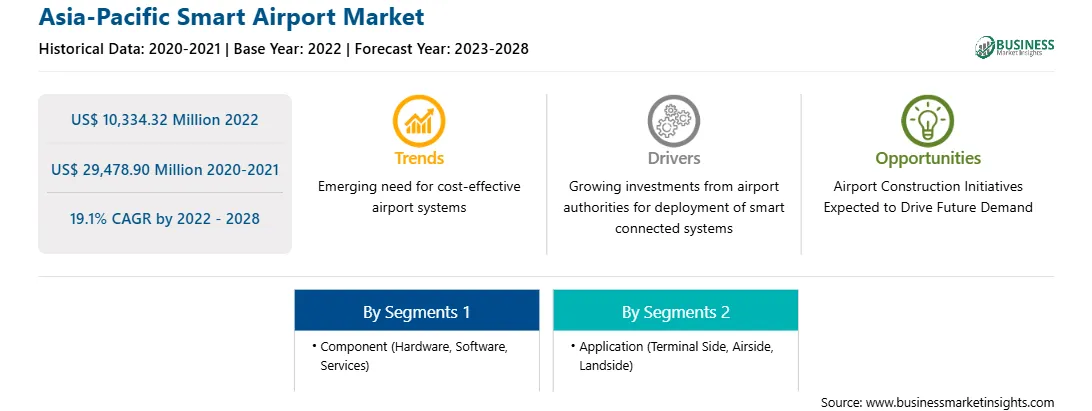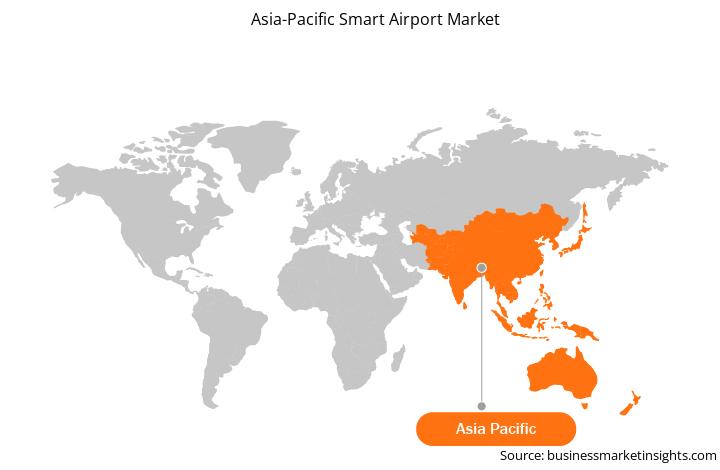亚太地区智能机场市场预测至 2028 年 - 按组件 [硬件(安全系统、通信和导航系统、端点设备和数据存储)和软件] 和应用程序(航站楼侧、空侧和陆侧)划分的 COVID-19 影响和区域分析)
No. of Pages: 131 | Report Code: BMIRE00027006 | Category: Aerospace and Defense
No. of Pages: 131 | Report Code: BMIRE00027006 | Category: Aerospace and Defense
亚太地区智能机场市场预计将从 2022 年的 103.3432 亿美元增长至 29,478.90 美元 百万;预计2022年至2028年复合年增长率为19.1%。
智慧机场企业行业专注于提供以客户为中心的解决方案,以促进智能机场技术的采用。该地区乘客对行李追踪的需求不断增加,这是机场当局关注的重点领域之一。据中国民航局 (CAAC) 统计,2021 年,约 75% 的中国航空旅客希望了解行李追踪详情和领取时间。根据同一研究,约 86% 的中国航空公司专注于提供行李跟踪通知,57% 的航空公司还向中国各地的乘客提供行李领取信息。智能机场市场的供应商专注于为航空公司提供智能航空行李管理系统,以实现业务运营自动化并为乘客提供更好的体验。此类系统与基于云的航空公司应用程序和数据库、基于云的分析以及机器对机器 (M2M) 和物联网平台集成,以连接、管理和保护来自智能行李的实时数据和事件。此外,在机场部署行李管理系统还有助于降低总体运营成本,同时提高总体运营效率。因此,供应商对以客户为中心的产品的关注预计将在未来几年推动该地区的市场增长。
随着新的功能和技术,供应商可以吸引新客户并扩大他们在新兴市场的足迹。这个因素很可能会推动。 亚太地区智能机场市场预计在预测期内将以良好的复合年增长率增长。
亚太地区智能机场市场细分;
亚太地区智能机场市场根据组件、应用程序和国家/地区进行细分。根据组件,亚太地区智能机场市场分为硬件和软件。 2022年,硬件领域将主导市场。硬件领域进一步分为安全系统、通信和导航系统、端点设备和数据存储。根据应用,亚太地区智能机场市场分为航站楼侧、空侧和陆侧。 2022年,航站楼侧市场占据主导地位。根据国家/地区,亚太地区智能机场市场分为中国、印度、日本、韩国、澳大利亚和亚太地区其他地区。 2022 年,中国将主导市场。
Amadeus IT Group SA;思科系统公司;柯林斯航空航天公司;大福有限公司;霍尼韦尔国际公司;华为技术有限公司;因德拉·西斯特玛斯 (Indra Sistemas),SA;西塔;泰雷兹集团;和 T-Systems 国际有限公司。是亚太地区智能机场市场的领先公司。
Strategic insights for Asia-Pacific Smart Airport involve closely monitoring industry trends, consumer behaviours, and competitor actions to identify opportunities for growth. By leveraging data analytics, businesses can anticipate market shifts and make informed decisions that align with evolving customer needs. Understanding these dynamics helps companies adjust their strategies proactively, enhance customer engagement, and strengthen their competitive edge. Building strong relationships with stakeholders and staying agile in response to changes ensures long-term success in any market.

| Report Attribute | Details |
|---|---|
| Market size in 2022 | US$ 10,334.32 Million |
| Market Size by 2028 | US$ 29,478.90 Million |
| Global CAGR (2022 - 2028) | 19.1% |
| Historical Data | 2020-2021 |
| Forecast period | 2023-2028 |
| Segments Covered |
By 组件
|
| Regions and Countries Covered | 亚太地区
|
| Market leaders and key company profiles |
The regional scope of Asia-Pacific Smart Airport refers to the geographical area in which a business operates and competes. Understanding regional nuances, such as local consumer preferences, economic conditions, and regulatory environments, is crucial for tailoring strategies to specific markets. Businesses can expand their reach by identifying underserved regions or adapting their offerings to meet regional demands. A clear regional focus allows for more effective resource allocation, targeted marketing, and better positioning against local competitors, ultimately driving growth in those specific areas.

The Asia-Pacific Smart Airport Market is valued at US$ 10,334.32 Million in 2022, it is projected to reach US$ 29,478.90 Million by 2028.
As per our report Asia-Pacific Smart Airport Market, the market size is valued at US$ 10,334.32 Million in 2022, projecting it to reach US$ 29,478.90 Million by 2028. This translates to a CAGR of approximately 19.1% during the forecast period.
The Asia-Pacific Smart Airport Market report typically cover these key segments-
The historic period, base year, and forecast period can vary slightly depending on the specific market research report. However, for the Asia-Pacific Smart Airport Market report:
The Asia-Pacific Smart Airport Market is populated by several key players, each contributing to its growth and innovation. Some of the major players include:
The Asia-Pacific Smart Airport Market report is valuable for diverse stakeholders, including:
Essentially, anyone involved in or considering involvement in the Asia-Pacific Smart Airport Market value chain can benefit from the information contained in a comprehensive market report.